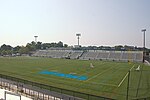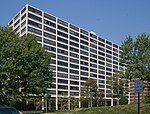Episcopal Diocese of Maryland
1780 establishments in MarylandAnglican dioceses established in the 18th centuryDioceses of the Episcopal Church (United States)Episcopal Church in MarylandEpiscopal bishops of Maryland ... and 2 more
Province 3 of the Episcopal Church (United States)Religious organizations established in 1780

The Episcopal Diocese of Maryland forms part of Province 3 of the Episcopal Church in the United States of America. Having been divided twice, it no longer includes all of Maryland and now consists of the central, northern, and western Maryland counties of Allegany, Anne Arundel, Baltimore, Calvert, Carroll, Frederick, Garrett, Harford, Howard, and Washington, as well as the independent city of Baltimore.
Excerpt from the Wikipedia article Episcopal Diocese of Maryland (License: CC BY-SA 3.0, Authors, Images).Episcopal Diocese of Maryland
East Bishops Road, Baltimore
Geographical coordinates (GPS) Address Nearby Places Show on map
Geographical coordinates (GPS)
| Latitude | Longitude |
|---|---|
| N 39.333333333333 ° | E -76.616666666667 ° |
Address
East Bishops Road 8
21218 Baltimore
Maryland, United States
Open on Google Maps







